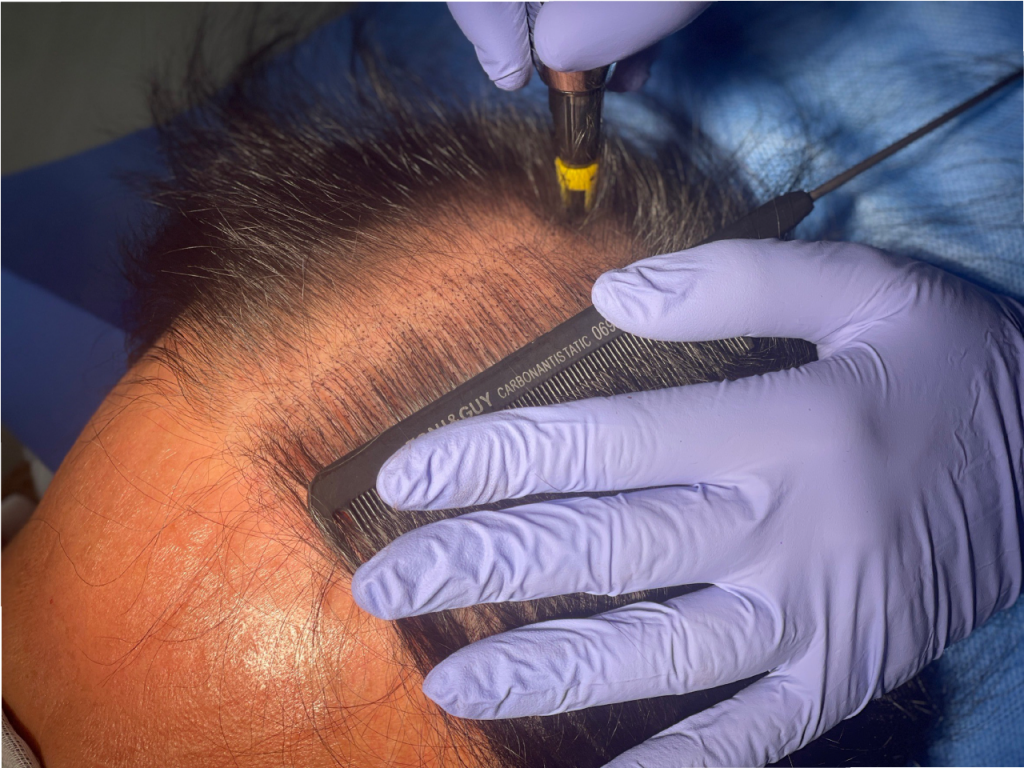Scalp pigmentation offers a versatile solution for various individuals seeking to enhance the appearance of their scalp. Let’s explore the different groups of people who can benefit from this innovative technique:
1. Women with Thin Hair: Many women experience thinning hair or have naturally fine hair. For those who are not suitable candidates for hair transplant surgery, scalp pigmentation provides an effective solution. It can effectively cover the scalp, providing immediate results that typically last an average of 3-5 years.
2. Men and Women with Thinning Hair: Hair thinning is a common concern for both genders. Scalp pigmentation offers a way to address this issue and achieve the appearance of thicker hair.
3. Post-Hair Transplant Patients: Individuals who have undergone hair transplantation may still seek a denser look. Scalp pigmentation can be performed after a transplant to enhance the density and provide a more consistent appearance.
4. Extensive Scalp Issues: Some individuals face more extensive scalp issues, such as those classified as Norwood class 6-7 baldness. In cases where donor grafts are limited, scalp pigmentation becomes a valuable option to create the illusion of a fuller head of hair.
5. Shaved Head Enthusiasts: For those who prefer a clean-shaven head but have thinning hair, scalp pigmentation offers an alternative. It can provide a uniform and natural look without the need for hair transplant surgery.
6. Challenges Due to Hair Conditions: Certain medical conditions like alopecia areata, cicatricial alopecia, or alopecia totalis make traditional hair transplant surgery unsuitable. Scalp pigmentation can be a viable option for individuals facing these challenges.
Scalp pigmentation, also known as tattooing, involves the careful implantation of pigment into the scalp skin. The depth of implantation may vary depending on the intended purpose, and the technique used aims to create a natural appearance.
This technique has a rich history, originally starting as a method for correcting scars and creating natural-looking tattoos. Over time, the principles and techniques of scalp pigmentation have been adapted for cosmetic purposes, including lip and eyebrow tattoos.
In the context of scalp pigmentation, the primary goal is to enhance the darkness of the scalp by applying black or dark brown pigments. However, the specific techniques used can vary based on the practitioner’s skills and the intended purpose of the pigmentation. Some individuals opt for scalp pigmentation to enhance security, while others seek a darker scalp appearance.
Scalp Micropigmentation (SMP) is a specialized form of this technique, primarily aiming to replicate the natural appearance of hair follicles. SMP has gained popularity in Western countries, particularly among those who prefer a shaved head look. It is performed to create the illusion of a full head of hair, even after shaving.
In the field of medicine, these pigmentation techniques have found application in covering scars resulting from hair transplant procedures. This practice has been further refined to use safe pigments that do not leave toxic substances in the body, ensuring a relatively painless procedure and quick recovery.
Whether you’re a woman seeking to address thinning hair, a man looking to enhance hair density, or someone with unique scalp challenges, scalp pigmentation offers a range of possibilities to achieve your desired look.



